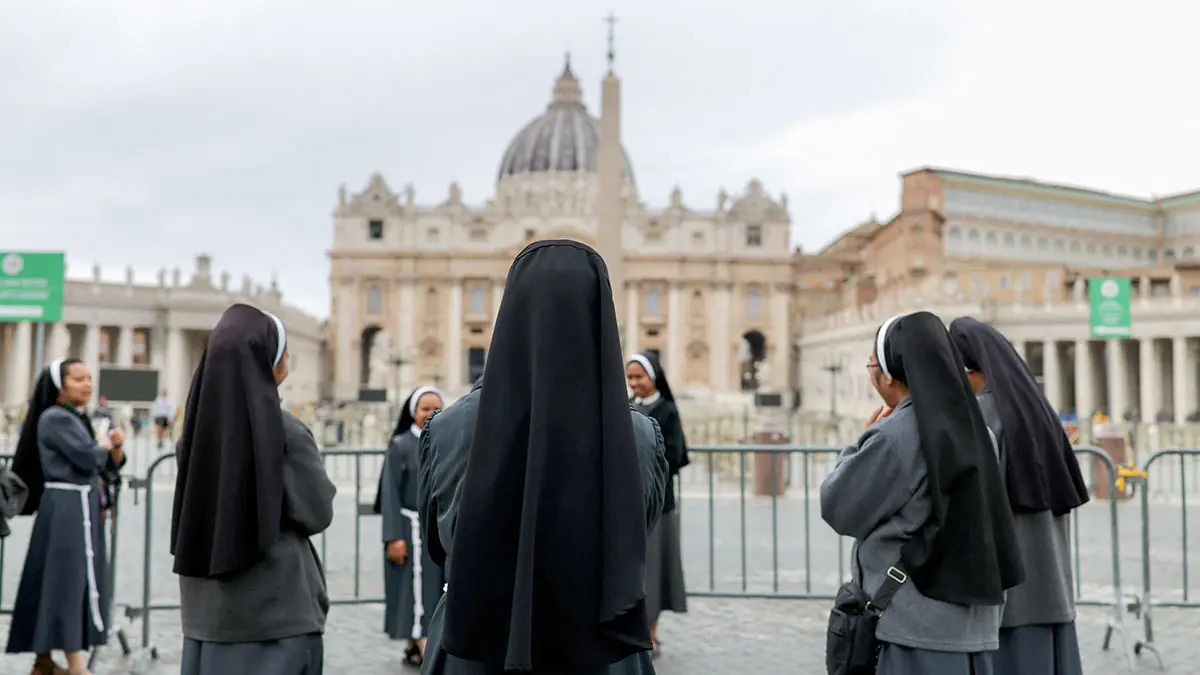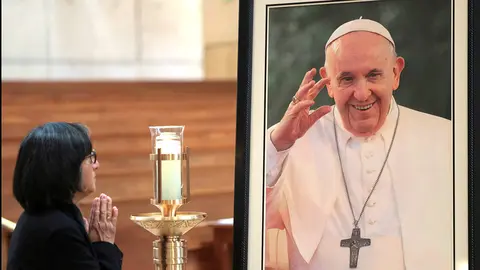Between Parolin and Tagle, the betting odds for the conclave to elect the new Pope

While in the Italian media, programmes with analysts debate the historical legacy of Pope Francis, hundreds of thousands of people from all over the world continue to mourn and pay their respects, with a procession that stretches from St. Peter's Basilica to the Basilica of Santa Maria Maggiore in Rome.
It is a six-kilometre journey that Catholic groups accompany with songs; some carry flowers, others candles. Everyone wants to get close to the Pope's niche to pray. With Jorge Mario Bergoglio dead, the legend of Francis is already being born.
As a priest in the slums of Buenos Aires, Bergoglio never imagined he would become Pontiff, but the cardinals' vote broke with tradition of anointing a European Pope, and he was finally elected on 13 March 2013.
It was already clear that there would be a shake-up and that he would break many moulds: Jesuit, Argentine, austere and with enough character to cut off the hands of the corruption that was eating away at the Holy See's budgets, proof of which is that he did not protect Pope Benedict XVI's inner circle.
The first to fall for embezzlement was Italian Cardinal Angelo Beccio, who was tried and sentenced to five years and six months in prison. This first action sent a very clear signal of what his pontificate would be like.
Outside the balcony, Pope Francis was much loved and popular, especially among the poorest and most vulnerable; however, behind the scenes, not everyone appreciated him: ‘They called him the Peronist pope,’ says a journalist with long experience in Vatican affairs.
The convocation of the conclave to elect the new Pope on 7 May will undoubtedly be surrounded by this mystique, for better or for worse. Following the death of Pope Francis, the Vatican has entered a period of sede vacante, with the College of Cardinals ready to meet and elect the next Supreme Pontiff. Among the main contenders, named by members of the press covering the Church in Rome, is Cardinal Luis Antonio Tagle, a prominent figure in the Philippine clergy and recognised as one of the most influential voices in the Church.
However, critics of the Supreme Pontiff have already labelled Tagle as the ‘Asian Francis’ because of his pastoral similarities and his good-natured and approachable style with the people.
Tagle currently serves as prefect of the Dicastery for Evangelisation, a key position in the Roman Curia to which he was appointed in 2022, and has extensive administrative and pastoral experience, having previously led the Archdiocese of Manila. He also served as president of Caritas Internationalis, the official global network of Catholic charitable organisations, from 2015 to 2022.
RAI, Italy's public television station, has raised the question of whether there should be a line of papal continuity, considering that Francis's great strength lay in his approach to younger generations.
In his twelve years as pope, he sowed many seeds, and although his pontificate was not as long as that of Pope John Paul II, which lasted twenty-seven years, it has been no less fruitful: the Francis era has had young people as its guiding principle.
In the days leading up to his funeral on 26 April, all access to St. Peter's Square was blocked by hundreds and hundreds of Catholic groups from parishes all over Italy who came with their teenagers and young people to pay their respects to the Pope. The Via della Conciliazione was a street full of young faces.
‘We admire and love him. What are we waiting for? Another Pope like him. Pope Francis never discriminated against anyone, he always had his arms open to include us all; that's why we will love him forever,’ Antonella, a trans girl from the Lazio neighbourhood of Rome, told me.
And indeed, Francis practised an open-door policy and, at least once a month, he met with LGTBIQ groups to whom he brought the word of God; he liked to explain to them that everyone counts for God.
Ada, a Mexican woman who sells rosaries in the Vatican, told me that she used to see the Pope on the street and go up to the shops: ‘He was hyperactive, he didn't like being cooped up and he often came to see us just to ask how we were. He had a great sense of humour and loved football... He was passionate about it, like a good Argentinean, and he also followed the Calcio matches.’
On RAI, they analyse whether he was better than John Paul II or whether each has earned a place in the history of the Papacy with a totally different personality. Politician and activist Andrea Riccardi talks about how momentous it will be to choose St. Peter's successor. ‘It won't be easy, and we may see a period of transition.’
Better than John Paul II? Yes, there is a rivalry in the Vatican between the two figures, because there are those who praise the pontificate of the Polish Karol Wojtyla as transcendental and unique, and those who highlight that Pope Francis brought back many lost Catholics and opened the Church wide so that no one felt discriminated against: not divorcees or non-heterosexuals.
Fundamentally, he was motivated to bring a message of hope and faith to Millennials, Generation Z and Generation Alpha, to whom he spoke about artificial intelligence, climate change, the information society, relationships and self-acceptance.
White smoke
With the date announced for the conclave on 7 May, 135 cardinals with an average age of 70 have been summoned to participate in the election and vote.
Most Italian media outlets, such as Corriere Della Sera, La Stampa and La Reppublica, take it for granted that Pietro Parolin, 75, born in Vicenza, will be the new Pontiff.
Parolin has a much more moderate spirit, according to Corriere Della Sera; he has extensive diplomatic and administrative experience, serves as Vatican Secretary of State and, following the Pope's death, is also the Camerlengo and current temporary head of the Catholic Church and the Vatican State.
In Mexico, he is remembered for his work at the Nunciature in Mexico and for helping to re-establish diplomatic relations with the Holy See on 21 September 1992.
According to information from the College of Cardinals, from 2002 to 2009, Parolin was undersecretary of state for relations with states: ‘An influential but discreet position, in which he directed relations with Vietnam, North Korea, Israel and China. In 2009, he was ordained bishop by Benedict XVI and appointed nuncio to Caracas; Pope Francis appointed Parolin Secretary of State in 2013; and in 2014, he appointed him a member of his internal Council of Cardinals to continue with the reforms of the Church.
Parolin also has the backing of secular diplomats. Not only must St. Peter's representative be chosen to lead the Church, but he will also be responsible for heading the Vatican State. He is a kind of prime minister with geopolitical influence.
In this sense, he has many points in his favour compared to the other cardinals. In the Vatican, sources consulted point out the following: ‘Parolin has used his diplomatic skills and growing network of contacts in a wide variety of areas, particularly in nuclear disarmament.’
He is also credited with playing a crucial role in re-establishing direct contact between the Holy See and Beijing in 2005, an achievement highly praised by Pope Francis himself. Parolin is an expert on Middle East affairs and the geopolitical situation in Asia.
‘His determined approach to Sino-Vatican relations culminated in 2018 with a controversial secret provisional agreement on the appointment of bishops, which has been renewed in 2020, 2022 and 2024,’ the sources consulted said.
In signing a provisional agreement with Beijing, the Holy See signalled its belief that this agreement, however imperfect, would help normalise the situation of some ten to twelve million Catholics in China. If there was one thing Pope Francis and Parolin, as his secretary of state, agreed on, it was that the rapprochement with China was not a political agreement, but a pastoral necessity.
Pope Francis' broader interest in Asia can be seen in the number of cardinals he appointed in the region in Singapore, Mongolia, East Timor, South Korea, Hong Kong, Mongolia, Japan, the Philippines and India; this move has also had an impact on the transformation of the College of Cardinals. This would be a point in favour of Filipino Cardinal Tagle.
Doing more missionary work in Asia was something that obsessed the Pope, as was achieving greater visibility throughout the world, thereby breaking with the old Eurocentric tradition. Thus, two currents could be seen in the conclave: one Asian, in favour of promoting Tagle, and the other European, with the intention of promoting Parolin.
For his critics, Cardinal Parolin is a modernist progressive with a globalist vision, a pragmatist who will put ideology and diplomatic solutions above the hard truths of the faith. His weak point: he is not popular outside the Church, has never served as a parish priest and has no direct experience in dealing with parishioners.
The vacuum phenomenon
The main concern among the cardinals in the conclave is to avoid a vacuum: repeating the same situation that occurred with Pope Benedict XVI, who took over the papacy after John Paul II left a deep mark and was much loved by the faithful. Benedict was overshadowed by that popularity, which only highlighted his lack of empathy and charisma.
The same could happen with Pope Francis: hundreds of faithful who felt embraced by his open-door policies, which excluded no one, could feel disappointed or left out if the cardinal who replaces him follows a line more closely aligned with the Bible and his encyclicals.
In this context, it will not be easy for someone else to come along who has neither his charisma, nor his humanity, nor his spark, nor those witticisms with which he used to win people over at first glance. Whoever comes will be under enormous pressure and under the scrutiny of the faithful and comparisons.
The figures for his papacy are also very positive: from 13 March 2013, when he was elected pontiff, until his death, the number of Catholics increased by 137,000; and, according to the Annuarium Statiscum Ecclesiae and the Pontifical Yearbook of 2024, there are 1,390,000 people baptised as Catholics in the world. 000 people baptised as Catholics worldwide.
In addition, an interesting phenomenon has occurred after his burial: people have rushed to pray at his niche in the Basilica of Santa Maria Maggiore, bringing flowers and candles, as if it were a mandatory pilgrimage; and in the streets, displays of affection continue days after the burial.
They are simply grateful people, mainly young people. In the Ottaviano-San Pietro metro, inside the carriage, a young man who calls himself ELG Emanuel sings rap songs that tell of the passing of a good man who cared about helping everyone: ‘If you want to know his name, I'll tell you, it's Francis, Francescus, and he's everyone's friend and we're going to miss him’. Without a doubt, it was twelve years of ploughing where it needed to be done. ‘Requiescat in pace Semper.’



